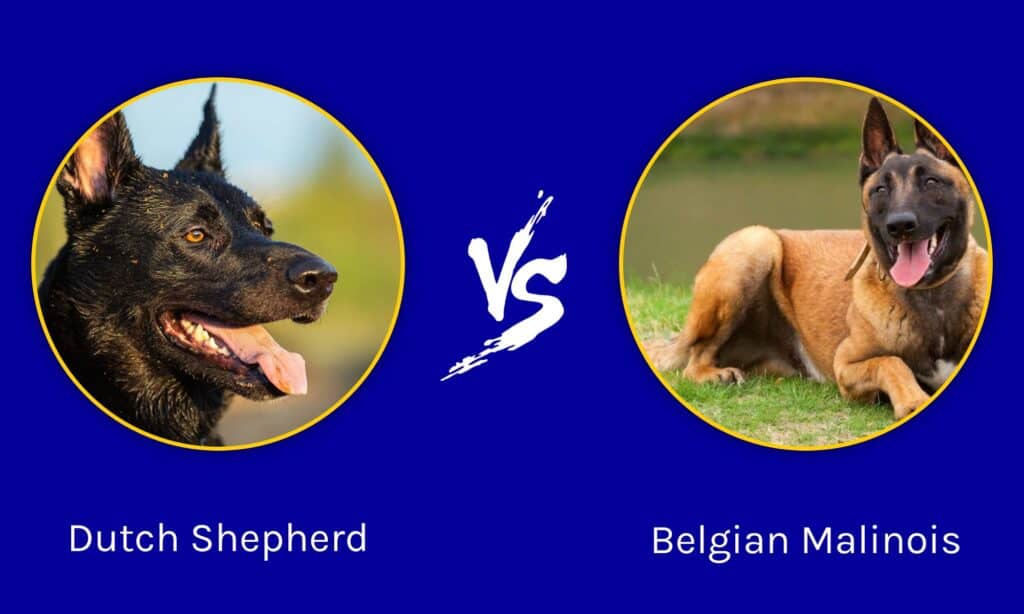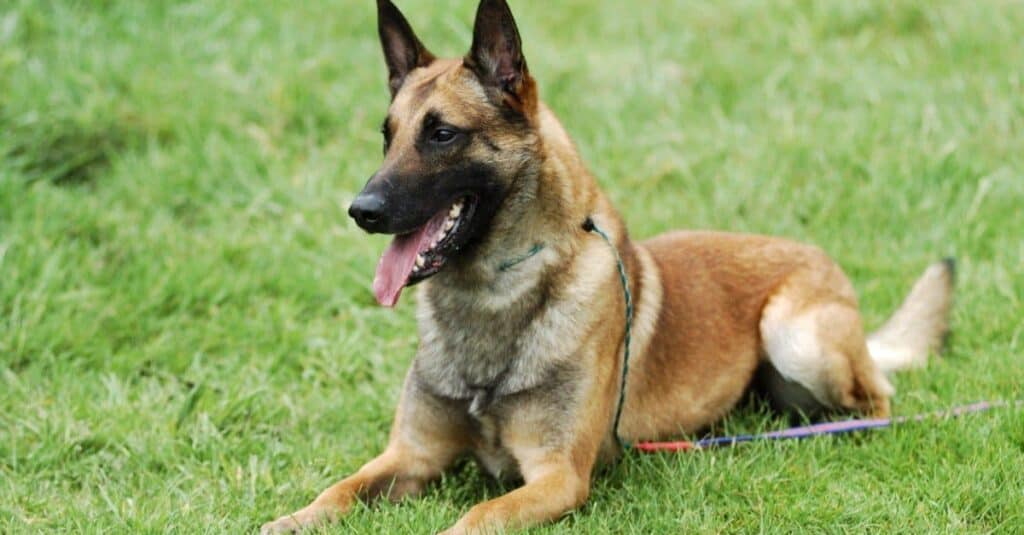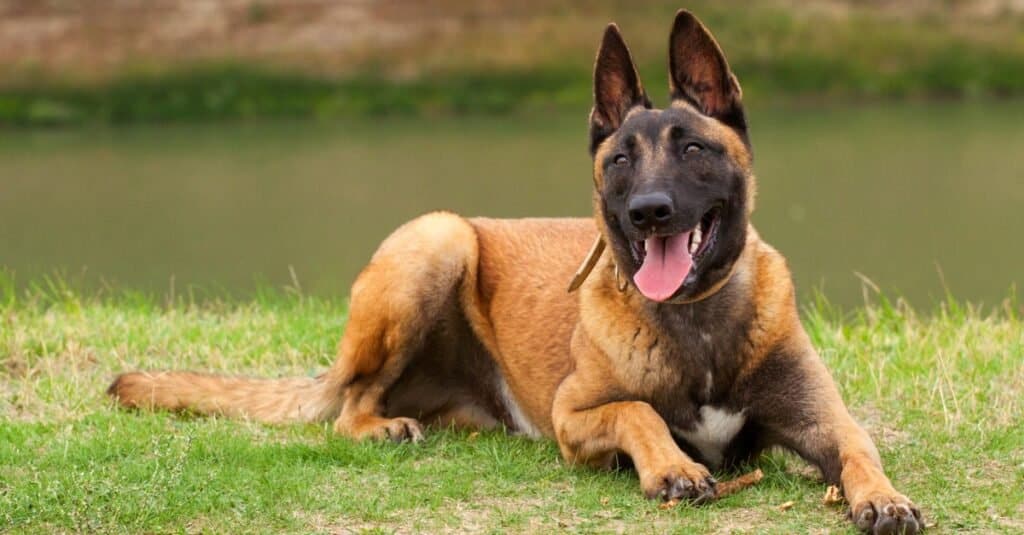Whether you’re looking for a herding dog or a protector, these two are a great choice! But when it comes down to the Dutch Shepherd vs Belgian Malinois, what are the differences between the two?
The Dutch Shepherd comes from the Netherlands as an all-around farm dog, tending to animals and children and guarding farms. Belgian Malinois has the consistency and willingness to stick with one job for a long period.
Read until the end to see which of these breeds—if either!—is right for you.
Comparing Dutch Shepherd vs Belgian Malinois

| Category | Dutch Shepherd | Belgian Malinois |
|---|---|---|
| Size | 21-25 inches, 42-75 pounds | 22-26 inches, 40-80 pounds |
| Appearance | Short, rough, or long fur in gold brindle or silver brindle | Short coat in fawn, mahogany, red, red sable, or fawn sable |
| Lifespan | 11-14 years | 14-16 years |
| Temperament | Affectionate, playful, and extremely protective | Protective |
| Barking Level | Low | Moderate |
| Drooling Level | Low | Very low |
| Grooming Needs | Varies by coat type | Weekly |
Key Differences Between a Dutch Shepherd and Belgian Malinois
The key difference between a Dutch Shepherd and a Belgian Malinois is their fur. Dutch Shepherds vary in fur length, while Belgian Malinois dogs are always short-haired.
They also vary a bit in size, lifespan, temperament, barking, and drooling.
Let’s explore these breeds in greater detail below!
Dutch Shepherd vs Belgian Malinois: Size

Dutch Shepherds are 21-25 inches tall, just slightly shorter than a Belgian Malinois.
©iStock.com/Tamara Harding
These dogs are very similar in size, but the breed standards do vary a little. Dutch Shepherds stand between 21-25 inches, while Belgian Malinois dogs are 22-26 inches tall. Dutch Shepherds weigh 42-75 pounds, and Belgian Malinois dogs weigh 40-80 pounds.
As you can see, they’re extremely close, with Belgian Malinois dogs being just barely larger.
These dogs sit in a comfortable middle ground when it comes to size. It’s important to note that their food and veterinary bills will cost more than smaller dogs; however, they won’t cost as much as some giant breeds!
Another reason that the size of your pup may matter to you is for guarding. These dogs both make great guard dogs and are likely to scare off any potential threats!
Dutch Shepherd vs Belgian Malinois: Appearance
Belgian Malinois dogs are always short-haired. The AKC breed standard accepts the following colors:
- Fawn
- Mahogany
- Red
- Red Sable
- Fawn Sable
Dutch Shepherds have three different coat types: short, long, and rough. The rough coat looks wiry and a bit messy in appearance (in the cutest way, though!). They’re only bred in two colors: gold brindle and silver brindle.
Dutch Shepherd vs Belgian Malinois: Lifespan
Belgian Malinois owners are lucky because these dogs live long lives for their size! The average is 14-16 years. Dutch Shepherds live between 11-14 years.
Remember, these are averages, meaning some dogs will live much shorter and some much longer. Variables that determine a dog’s lifespan include genetics, health, and care.
Of course, a dog on the street isn’t likely to live as long as one in a loving home!
To give your dog the best shot at a long life, feed them a well-balanced diet, give them plenty of daily exercise, and bring them to the veterinarian regularly. Monitoring your dog for changes in behavior and other symptoms is important because dogs tend to hide their illnesses. Knowing your dog well is key to catching health problems early.
Dutch Shepherd vs Belgian Malinois: Temperament
You’ll likely notice a few differences in behavior between these breeds: affection level, playfulness, and protectiveness. Dutch Shepherds generally tend to be more affectionate with family—and more protective. They may cling to your side or love to cuddle in your lap!
It’s important to get all dogs used to being alone early in life, but especially clingier breeds, as this trait can lead to separation anxiety. Introduce the concept early and accept your dog’s limitations. No dog should be home alone for the majority of the day.
Lastly, Dutch Shepherds tend to be more playful! They’re more likely to engage you in play and may insist even when you want to relax. However, it should be noted that both breeds are very high-energy, as we’ll discuss further below!
Of course, every dog is an individual—you might have a very clingy Malinois or a Shepherd who doesn’t play as much as others. Personality and history affect the way a dog acts just as much as their genetics.
Dutch Shepherd vs Belgian Malinois: Barking Level
Neither of these breeds is very likely to bark excessively. The Dutch Shepherd typically barks to alert but won’t go on forever—especially once properly trained. Belgian Malinois dogs are moderate barkers.
Remember, these dogs have protective natures and see it as their job to alert you to the goings-on of the neighborhood. Don’t scold them for doing what they’ve been bred to do! If you notice problematic barking behavior, first ensure your dog is getting enough exercise every day. Boredom is the number one cause of behavioral issues!
Also, make sure you aren’t leaving them alone in the yard for long periods. This leads to boredom and frustration as the dog isn’t being properly cared for. If your dog barks while alone indoors, it may be a case of separation anxiety.
Lastly, excessive barking can be a result of poor training. If you want to stop the behavior, first teach your dog to “speak.” This should be super easy since they’re already doing it so often!
Once they can speak on command, you’ll have more control over the behavior. Now, tell your dog to speak and wait for it to stop. When it does, treat it. Eventually, add in the “quiet” command.
Over time, you’ll be able to work up to using “quiet” to get your dog to hush when they’re barking at something for real.
Dutch Shepherd vs Belgian Malinois: Drooling Level

Neither breed drools much, but Belgian Malinois dogs drool the least.
©iStock.com/RKSS
If you’re looking for a dog who seldom drools, either breed is a good option! Dutch Shepherds do drool a bit more than Belgian Malinois dogs, though.
Still, it’s less than the average dog. You’ll likely notice the most drool around the food and water dishes when your dog is begging or when it is asleep.
Dutch Shepherd vs Belgian Malinois: Grooming
Belgian Malinois can get by with an occasional brushing, but it’s best to brush them weekly. This will lessen the amount of shed fur and keep their coat and skin healthy.
Dutch Shepherds vary in their grooming needs depending on their coat type. Short hairs need to be groomed occasionally, long-hairs weekly, and rough-hair monthly. Rough-haired dogs will also need their coat hand-stripped once yearly.
During shedding season twice yearly, Belgian Malinois dogs, short-haired Dutch Shepherds, and long-haired Shepherds will need to be brushed daily to keep up with their increased shed.
Dutch Shepherd vs Belgian Malinois: Exercise and Training

Unfortunately, neither the Dutch Shepherd nor the Belgian Malinois is a good dog for first-time pet parents.
©Fesus Robert/Shutterstock.com
Although these dogs have remarkably similar exercise and training needs, I do want to touch on them! It’s important to note that these breeds aren’t great for beginners.
Firstly, they require an immense amount of exercise each day. A daily walk or even two won’t be enough—they want high-impact exercise like hands-on play in the backyard, hikes, or runs.
These dogs are also incredibly smart and need mental stimulation to keep them healthy and on their best behavior. A bored dog will get into all sorts of trouble.
Many dog owners blame their dogs for destructive behaviors, excessive barking, and other behavioral problems. But the truth is that the dogs who showcase these behaviors often aren’t being cared for properly.
They don’t do well left in the backyard to fend for themselves but need to live with families where someone is home most of the day.
These breeds also come with their training struggles. This includes a high prey drive that requires a leash or enclosure at all times. Recall can and should be trained in case of emergency but should not be relied upon when a dog is on the chase. Their intelligence means these breeds do best with short training sessions and little repetition. Though they’re eager to please, they will become bored easily.
Belgian Malinois dogs also have a tendency to chase children or small pets. This can quickly become dangerous and must be trained out while they’re young.
These breeds make terrific pets, but only for very active people who can train them well and spend a lot of time with their dogs.
‘Belgian Malinois / Dutch Shepherd’ Cross Breeding
When Belgian Malinois is cross bred with Dutch Shepherd, you get Mali-dutchie. Mali-dutchie is a unique blend of both breeds and has the qualities of both lines. The litter may vary greatly in color and appearance, however, the breed is a very beautiful one. Here are some things you should know about the Belgian Malionois Dutch Shepherd or the Mali-dutchie
- They have a short coat that can withstand all kinds of weather
- They have unique colors, even in one litter each pup can have different coloring
- They prefer cold weathers to warm and humid climates
- They shed a lot, and need regular grooming and brushing
- They have large ears, are built for action and have very intelligent disposition
- Male mali-dutchie can grow up to 26 inches in height and around 80 lbs in weight
- Female mali-dutchie grow up to 24 inches and 70 lbs in wieght
- They can live up to 16 years and require lots of physical activities
Since the parent breeds are used for seeing-eye dog, police service, search and rescue work, and other services such as guarding or herding other animals, Mali-dutchie are of similar disposition and are unlikely to be very physical or touchy-feely. They likely won’t cuddle or snuggle with you a lot, however, they make great service dogs just like their parents.
Why do Police Forces use Belgian Malinoises instead of German Shepherds?

Belgian Malinoises are being used more and more often instead of German Shepherds for police work.
©Frank Craddock / CC BY-SA 4.0 – License
For many years back, German Shepherds have been the dog breed that has been directly associated with police work. Police K-9s have historically been these beautiful and intelligent dogs. In more modern times, however, police and other law enforcement agencies around the world have been preferring Belgian Malinoises over them.
While there may not be overwhelming evidence for this, more dog trainers claim that Belgian Malinoises develop and pick up their training quicker than German Shepherds. Because they tend to learn integral lessons in less time, it is obviously advantageous for agencies to use them to get them introduced into the working field that much faster. This can be attributed to their greater endurance level and overall curiosity. Highly trained and motivated working dogs are in high demand, so German Shepherds are getting pushed to the back of the list.
The photo featured at the top of this post is © iStock.com/RKSS
Ready to discover the top 10 cutest dog breeds in the entire world?
How about the fastest dogs, the largest dogs and those that are -- quite frankly -- just the kindest dogs on the planet? Each day, AZ Animals sends out lists just like this to our thousands of email subscribers. And the best part? It's FREE. Join today by entering your email below.
Thank you for reading! Have some feedback for us? Contact the AZ Animals editorial team.






